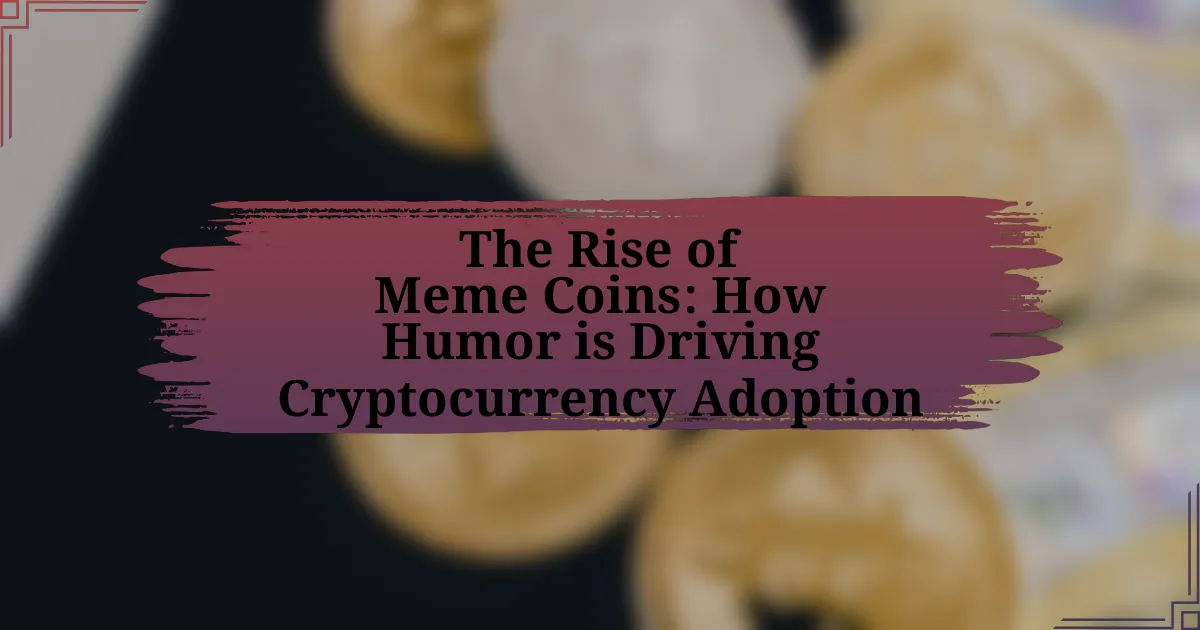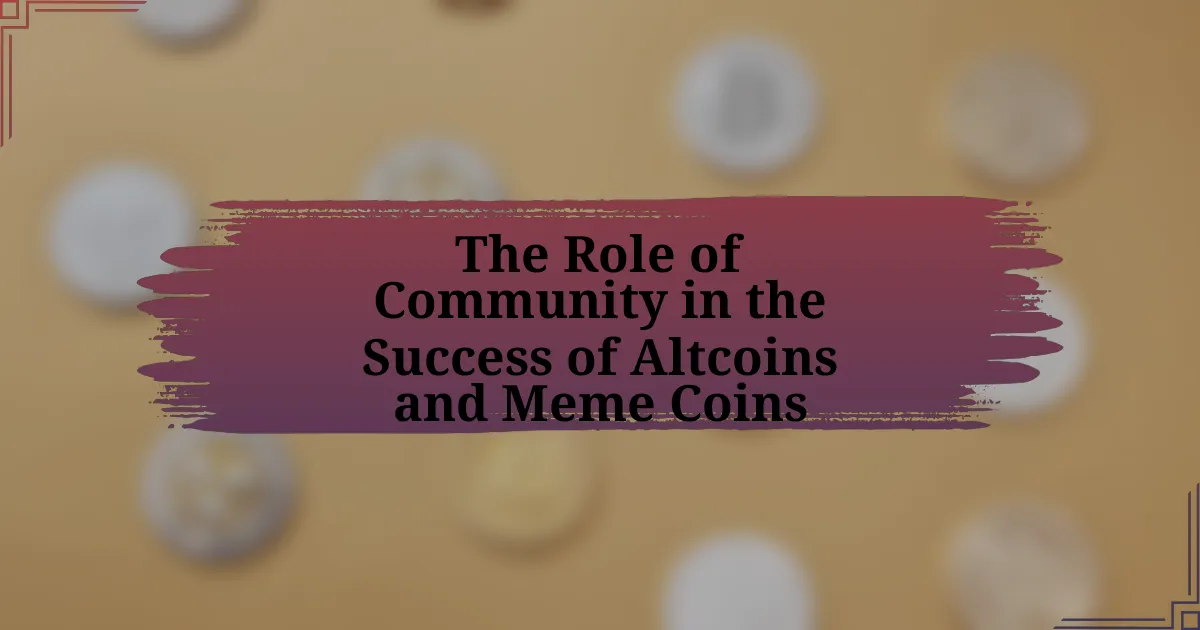Altcoins are cryptocurrencies other than Bitcoin, designed to enhance or provide alternatives to Bitcoin’s features, while meme coins are a subset of altcoins created primarily for entertainment or as jokes, often lacking substantial utility. The article explores the differences and similarities between these two categories, detailing their purposes, technological distinctions, community dynamics, and market influences. It also addresses the risks associated with investing in both altcoins and meme coins, highlighting factors that affect their value and strategies for responsible investment. Key categories of altcoins, their use cases, and the role of social media in the popularity of meme coins are also examined.
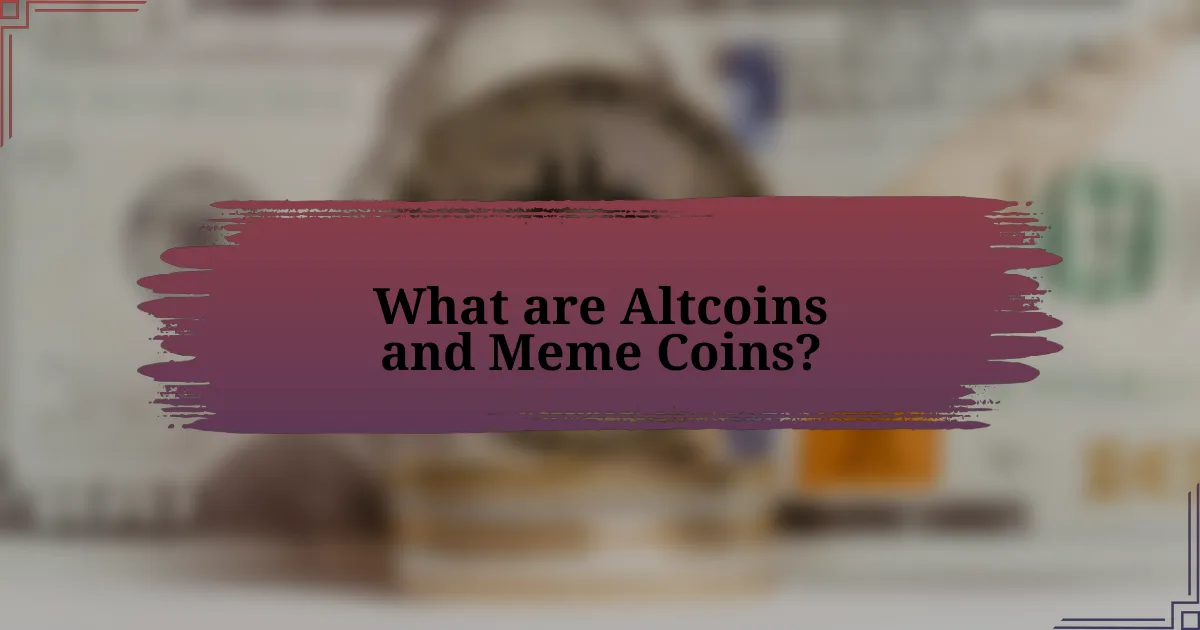
What are Altcoins and Meme Coins?
Altcoins are cryptocurrencies other than Bitcoin, created to improve upon or offer alternatives to Bitcoin’s features. They encompass a wide range of digital currencies, including Ethereum, Ripple, and Litecoin, each designed with specific functionalities or use cases, such as smart contracts or faster transaction speeds. Meme coins, on the other hand, are a subset of altcoins that are often created as a joke or for entertainment purposes, with Dogecoin being the most notable example. These coins typically gain popularity through social media and community engagement rather than technological advancements or utility. The distinction lies in their purpose and market perception, with altcoins generally aiming for serious applications while meme coins focus on community-driven hype and humor.
How do Altcoins differ from traditional cryptocurrencies?
Altcoins differ from traditional cryptocurrencies primarily in their purpose and functionality. While traditional cryptocurrencies like Bitcoin serve as a digital currency and store of value, altcoins often aim to provide additional features, such as smart contracts, privacy enhancements, or specific use cases within decentralized applications. For instance, Ethereum, a prominent altcoin, enables developers to create decentralized applications through its smart contract functionality, which Bitcoin does not support. This distinction highlights how altcoins can cater to various niches in the blockchain ecosystem, expanding the utility beyond what traditional cryptocurrencies offer.
What categories of Altcoins exist?
Altcoins exist in several categories, including utility tokens, security tokens, stablecoins, and governance tokens. Utility tokens provide access to a product or service within a blockchain ecosystem, such as Ethereum’s Ether, which is used for transactions and smart contracts. Security tokens represent ownership in an asset and are subject to regulatory oversight, exemplified by tokens like Polymath. Stablecoins are pegged to a stable asset, such as the US dollar, to minimize volatility, with Tether (USDT) being a prominent example. Governance tokens allow holders to participate in decision-making processes within a blockchain project, such as MakerDAO’s MKR token. These categories help differentiate the various functions and purposes of altcoins in the cryptocurrency market.
What are the primary use cases for Altcoins?
The primary use cases for Altcoins include facilitating transactions, enabling smart contracts, and providing decentralized finance (DeFi) solutions. Altcoins, such as Ethereum, allow developers to create decentralized applications (dApps) through smart contracts, which automate processes without intermediaries. Additionally, many Altcoins serve as a medium of exchange or store of value, similar to Bitcoin, but often with enhanced features or lower transaction fees. For instance, Ripple (XRP) is designed for fast and cost-effective cross-border payments, showcasing the diverse functionalities of Altcoins in the cryptocurrency ecosystem.
What defines a Meme Coin?
A meme coin is a type of cryptocurrency that is primarily created as a joke or for entertainment purposes, often inspired by internet memes or cultural phenomena. These coins typically lack a fundamental utility or technological innovation compared to traditional cryptocurrencies, focusing instead on community engagement and social media presence. For example, Dogecoin, which started as a meme featuring the Shiba Inu dog, gained significant popularity and market capitalization despite its initial lack of serious purpose. This phenomenon illustrates how meme coins can attract large communities and speculative investment, often driven by viral trends rather than intrinsic value.
How did Meme Coins originate and gain popularity?
Meme coins originated as a playful take on cryptocurrency, with Dogecoin, created in December 2013 as a parody of Bitcoin, being the first and most notable example. Their popularity surged due to social media influence, particularly platforms like Twitter and Reddit, where communities rallied around these coins, often driven by humor and memes. The rise of meme coins was further fueled by celebrity endorsements, such as Elon Musk’s tweets about Dogecoin, which significantly impacted their market value and visibility. This combination of community engagement, social media virality, and speculative trading led to the rapid growth and mainstream recognition of meme coins in the cryptocurrency market.
What are the characteristics of successful Meme Coins?
Successful Meme Coins typically exhibit strong community engagement, viral marketing potential, and a unique branding identity. Community engagement is crucial as it fosters loyalty and encourages user participation, often seen in platforms like Dogecoin, which has a dedicated following. Viral marketing potential allows these coins to gain rapid popularity through social media and online forums, exemplified by Shiba Inu’s explosive growth driven by social media trends. A unique branding identity differentiates successful Meme Coins from traditional cryptocurrencies, often leveraging humor or pop culture references, which enhances relatability and appeal. These characteristics collectively contribute to the market performance and longevity of Meme Coins in the cryptocurrency landscape.
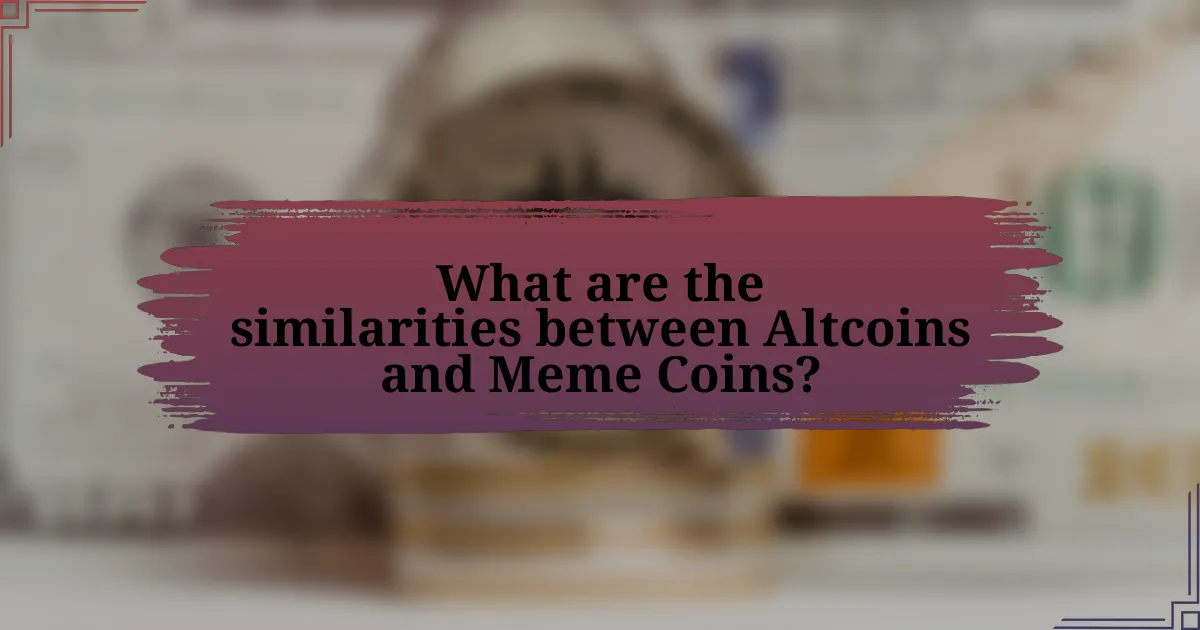
What are the similarities between Altcoins and Meme Coins?
Altcoins and meme coins share several similarities, primarily in their status as cryptocurrencies and their reliance on community engagement for value. Both categories exist outside of Bitcoin, with altcoins often serving specific use cases or functionalities, while meme coins typically derive their value from social media trends and community-driven hype. Additionally, both altcoins and meme coins can experience high volatility and speculative trading, attracting investors looking for potential short-term gains. This volatility is evidenced by the rapid price fluctuations seen in both markets, often influenced by market sentiment and social media activity.
How do both types of coins operate within the cryptocurrency market?
Altcoins and meme coins operate in the cryptocurrency market by serving different purposes and attracting distinct investor bases. Altcoins, which include any cryptocurrency other than Bitcoin, often aim to improve upon Bitcoin’s technology or offer unique features, such as smart contracts or enhanced privacy. For example, Ethereum introduced smart contracts, enabling decentralized applications, while Ripple focuses on facilitating cross-border payments. In contrast, meme coins, such as Dogecoin and Shiba Inu, primarily gain popularity through community engagement and social media trends rather than technological advancements. Their value is often driven by speculation and viral marketing rather than fundamental utility. This distinction highlights how altcoins generally seek to provide functional improvements within the market, while meme coins capitalize on cultural phenomena and community-driven hype.
What role do community and social media play in both Altcoins and Meme Coins?
Community and social media play a crucial role in the success and adoption of both Altcoins and Meme Coins by fostering engagement, driving awareness, and influencing market sentiment. For Altcoins, communities often contribute to development, governance, and marketing efforts, as seen with projects like Ethereum, where community input shapes protocol upgrades. In the case of Meme Coins, social media platforms like Twitter and Reddit are instrumental in creating viral trends and driving speculative interest, exemplified by Dogecoin’s rise, which was largely fueled by community-driven campaigns and memes shared across these platforms. The active participation of users in discussions and promotions on social media directly impacts the perceived value and popularity of these cryptocurrencies, demonstrating the significant influence of community dynamics in the crypto space.
How do Altcoins and Meme Coins impact market trends?
Altcoins and meme coins significantly impact market trends by influencing investor sentiment and market volatility. Altcoins, which are alternative cryptocurrencies to Bitcoin, often drive innovation and diversification in the market, attracting institutional investment and leading to price fluctuations based on technological advancements or partnerships. For instance, Ethereum’s rise has historically correlated with increased interest in decentralized finance (DeFi) projects, showcasing how altcoins can set trends.
Meme coins, on the other hand, primarily affect market trends through social media hype and community engagement. The rapid price movements of coins like Dogecoin and Shiba Inu demonstrate how viral marketing and celebrity endorsements can lead to sudden spikes in trading volume and market capitalization. In 2021, Dogecoin’s market cap surged to over $85 billion, largely driven by social media trends and community-driven initiatives, illustrating the power of meme coins in shaping market dynamics.
What are the common risks associated with investing in Altcoins and Meme Coins?
Investing in Altcoins and Meme Coins carries several common risks, including high volatility, lack of regulation, and potential for scams. High volatility is evident as many Altcoins and Meme Coins can experience significant price fluctuations within short time frames, leading to substantial financial losses. The lack of regulation in the cryptocurrency market means that investors may face challenges in recovering funds in cases of fraud or mismanagement. Additionally, the prevalence of scams, particularly in the Meme Coin sector, poses a risk as many projects lack transparency and may not have a viable business model, resulting in investors losing their entire investment.
How does market volatility affect both types of coins?
Market volatility significantly impacts both altcoins and meme coins, but in different ways. Altcoins, which often have more established use cases and market fundamentals, may experience price fluctuations that reflect broader market trends, investor sentiment, and technological developments. For instance, during periods of high volatility, altcoins can see substantial price corrections or rallies based on news or regulatory changes, as evidenced by the sharp price movements of Ethereum and Ripple during market downturns.
In contrast, meme coins, which are often driven by social media trends and speculative trading, tend to react more dramatically to market volatility. Their prices can surge or plummet based on viral trends or community sentiment rather than intrinsic value. For example, Dogecoin experienced extreme price volatility in 2021, largely influenced by social media hype and endorsements from celebrities, demonstrating how market fluctuations can lead to rapid and unpredictable price changes in meme coins.
What are the potential scams or pitfalls investors should be aware of?
Investors should be aware of several potential scams and pitfalls, including pump-and-dump schemes, rug pulls, and misleading marketing tactics. Pump-and-dump schemes involve artificially inflating the price of an asset through false or misleading statements, leading to significant losses for those who buy in at inflated prices. Rug pulls occur when developers abandon a project after attracting investment, leaving investors with worthless tokens. Misleading marketing tactics often exaggerate the potential returns of altcoins or meme coins without disclosing risks, which can lead to uninformed investment decisions. According to a report by the Blockchain Research Institute, over 80% of initial coin offerings (ICOs) in 2017 were identified as scams, highlighting the prevalence of fraudulent activities in the cryptocurrency space.
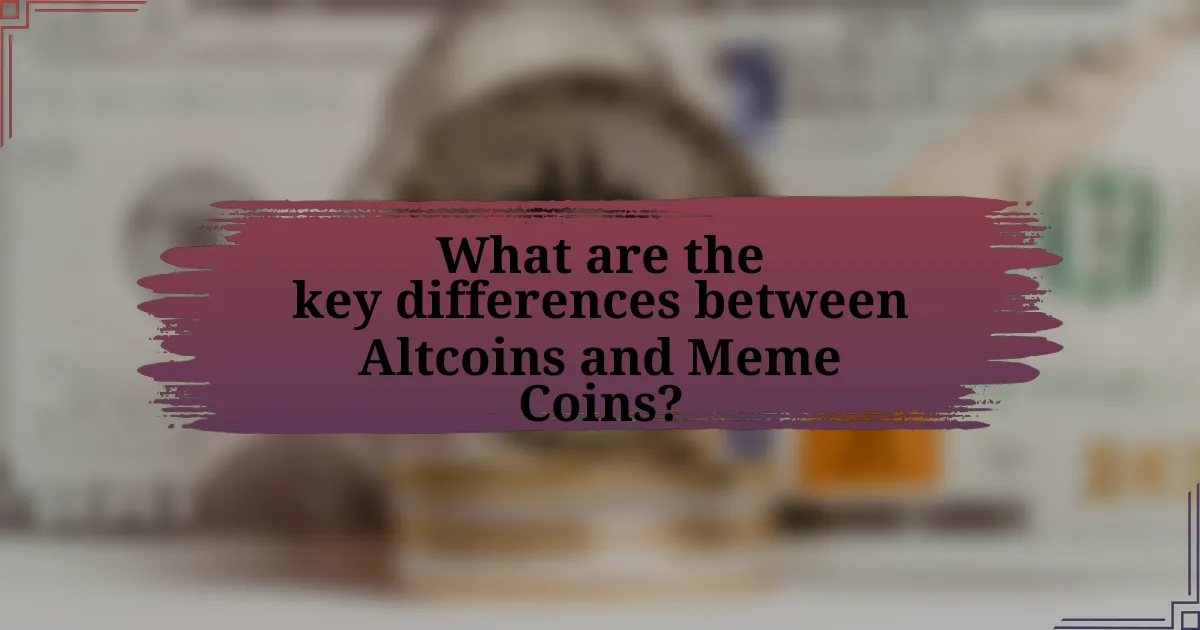
What are the key differences between Altcoins and Meme Coins?
Altcoins are alternative cryptocurrencies to Bitcoin that often serve specific use cases or functionalities, while meme coins are cryptocurrencies created primarily for entertainment or as a joke, often lacking substantial utility. Altcoins, such as Ethereum and Litecoin, typically have defined purposes, like enabling smart contracts or faster transactions, and are often backed by robust development teams and communities. In contrast, meme coins, like Dogecoin and Shiba Inu, gain popularity through social media and community engagement rather than technological innovation or utility. The market capitalization and trading volume of altcoins generally reflect their utility and adoption, whereas meme coins often experience volatility driven by trends and speculation rather than fundamental value.
How do the purposes of Altcoins and Meme Coins differ?
Altcoins primarily serve as alternatives to Bitcoin, aiming to improve upon its technology or offer unique features, such as faster transaction speeds or enhanced privacy. In contrast, meme coins are often created as jokes or for entertainment, lacking serious technological advancements or utility, with their value largely driven by community sentiment and social media trends. For example, Dogecoin, a well-known meme coin, was initially developed as a parody of Bitcoin but gained popularity due to its community and viral marketing, while Ethereum, an altcoin, introduced smart contracts, significantly expanding blockchain functionality.
What are the technological differences between Altcoins and Meme Coins?
Altcoins are cryptocurrencies that serve various purposes and often have unique technological features, while meme coins are primarily created for entertainment or community engagement, lacking significant technological advancements. Altcoins typically utilize advanced blockchain technologies, smart contracts, and specific use cases, such as decentralized finance or supply chain management. For example, Ethereum, a prominent altcoin, enables developers to create decentralized applications through its smart contract functionality. In contrast, meme coins like Dogecoin are often based on existing blockchain protocols with minimal modifications and primarily rely on community support and social media for value, rather than technological innovation. This distinction highlights that altcoins generally focus on solving real-world problems through technology, whereas meme coins prioritize cultural relevance and community engagement over technological sophistication.
How do the communities surrounding Altcoins and Meme Coins vary?
The communities surrounding Altcoins and Meme Coins vary significantly in their focus and engagement. Altcoin communities typically prioritize technological advancements, investment strategies, and long-term project viability, often engaging in discussions about blockchain technology, market trends, and development updates. In contrast, Meme Coin communities are often centered around humor, social media trends, and viral marketing, with a focus on community-driven initiatives and speculative trading rather than technological innovation. This difference is evidenced by the fact that many Altcoin projects have dedicated development teams and roadmaps, while Meme Coins often rely on community engagement and social media presence to drive interest and value.
What factors influence the value of Altcoins compared to Meme Coins?
The value of Altcoins is influenced by factors such as utility, technology, market adoption, and regulatory compliance, while Meme Coins primarily rely on community sentiment and social media trends. Altcoins often have specific use cases, such as facilitating transactions or enabling smart contracts, which can drive demand and increase their value. For example, Ethereum’s smart contract functionality has led to widespread adoption and a significant market cap. In contrast, Meme Coins like Dogecoin gain value largely through viral marketing and community engagement, lacking intrinsic utility. The volatility of Meme Coins is often higher due to their dependence on speculative trading and trends, whereas Altcoins tend to have more stable valuations based on their underlying technology and market fundamentals.
How does market perception affect the valuation of each type?
Market perception significantly influences the valuation of altcoins and meme coins, as it shapes investor sentiment and demand. For altcoins, positive market perception often leads to increased adoption and higher valuations, driven by their utility, technological advancements, and real-world applications. Conversely, meme coins typically rely on social media trends and community engagement; thus, their valuation can fluctuate dramatically based on public sentiment and viral marketing. For instance, the rise of Dogecoin was largely fueled by social media hype and endorsements from influencers, demonstrating how market perception can lead to rapid valuation increases.
What role does utility play in the value of Altcoins versus Meme Coins?
Utility significantly influences the value of Altcoins compared to Meme Coins, as Altcoins typically offer specific functionalities or use cases within their ecosystems, while Meme Coins often lack inherent utility and rely on community sentiment and speculation. For instance, many Altcoins, such as Ethereum, provide platforms for decentralized applications and smart contracts, which enhances their value proposition and adoption. In contrast, Meme Coins like Dogecoin primarily derive their value from social media trends and community engagement rather than functional applications, leading to higher volatility and less sustainable value. This distinction highlights that the presence of utility in Altcoins generally correlates with more stable and long-term value compared to the speculative nature of Meme Coins.
What should investors consider when choosing between Altcoins and Meme Coins?
Investors should consider the underlying technology, use case, and market volatility when choosing between Altcoins and Meme Coins. Altcoins typically offer innovative solutions, established use cases, and are often backed by solid development teams, making them more suitable for long-term investment. In contrast, Meme Coins are primarily driven by social media trends and community sentiment, leading to higher volatility and speculative trading. For instance, Bitcoin and Ethereum, as prominent Altcoins, have demonstrated significant market stability and utility, while Meme Coins like Dogecoin have experienced rapid price fluctuations based on viral trends.
What strategies can be employed for investing in Altcoins?
Investing in Altcoins can be effectively approached through several strategies, including diversification, thorough research, and risk management. Diversification involves spreading investments across multiple Altcoins to mitigate risk, as the cryptocurrency market can be highly volatile. Thorough research entails analyzing the fundamentals of each Altcoin, such as its use case, development team, and market potential, which can lead to more informed investment decisions. Risk management is crucial; setting stop-loss orders and only investing what one can afford to lose helps protect against significant losses. These strategies are supported by the fact that a diversified portfolio can reduce overall risk, as evidenced by studies showing that diversified investments tend to perform better over time compared to concentrated ones.
How can investors approach Meme Coin investments responsibly?
Investors can approach Meme Coin investments responsibly by conducting thorough research and only investing what they can afford to lose. This involves analyzing the project’s fundamentals, community engagement, and market trends, as many Meme Coins lack intrinsic value and are highly speculative. For instance, a study by the University of Cambridge highlights that over 90% of new cryptocurrencies fail within the first few years, emphasizing the importance of due diligence. Additionally, diversifying investments and avoiding emotional trading can mitigate risks associated with the volatility of Meme Coins.

